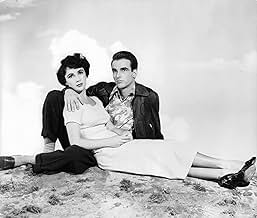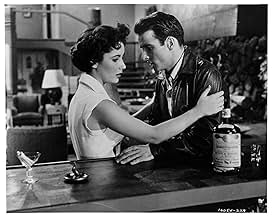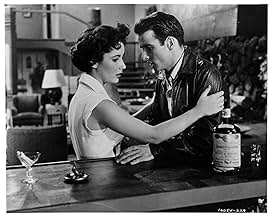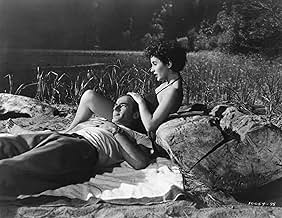IMDb रेटिंग
7.7/10
26 हज़ार
आपकी रेटिंग
एक गरीब लड़का अपने अमीर चाचा के लिए नौकरी करता है और अंततः उसे दो महिलाओं से प्यार हो जाता है.एक गरीब लड़का अपने अमीर चाचा के लिए नौकरी करता है और अंततः उसे दो महिलाओं से प्यार हो जाता है.एक गरीब लड़का अपने अमीर चाचा के लिए नौकरी करता है और अंततः उसे दो महिलाओं से प्यार हो जाता है.
- 6 ऑस्कर जीते
- 18 जीत और कुल 12 नामांकन
Robert J. Anderson
- Eagle Scout
- (बिना क्रेडिट के)
Gertrude Astor
- Bit Part
- (बिना क्रेडिट के)
फ़ीचर्ड समीक्षाएं
Time does extraordinary things with greatness. If nothing else it confirms it. "A Place in the Sun" is a remarkable example of that theory. I rushed to buy a DVD after watching a BBC documentary on ELizabeth Taylor to celebrate her 75th birthday! In "A Place on the Sun" an Elizabeth Taylor barely out of her teens is paired with Montgomery Clift. She had been raised at MGM and groomed for movie stardom from day one. He was a method actor, complex, introspective and their coupling produced something that I'm tempted to call, unrepeatable. The actors own personal stories, their friendship, mutual love and respect made it possible for their communion to be so transcendental. To make things even more perfect, the film seems a love letter from director George Stevens to his stars and vice versa. Look at the opening credits and tell me if you've ever seen a more startling introduction to a character/star. The story of doomed love and descend into darkness is, without question, one of the best ever made.
Poor and uneducated George Eastman (Montgomery Clift) unwittingly sets a trap for himself when he takes an entry-level job at his rich uncle's factory, which has a prohibition on male employees dating female employees. He just can't resist one of the girls in his department, the pitiful and whiny Alice Tripp (wonderfully played by Shelley Winters). Eventually, George gets a promotion and is invited into the upper echelon of his uncle's social world, where he meets wealthy and beautiful Angela Vickers (a breathless Elizabeth Taylor). Naturally, he falls in love with Angela. But a complication with Alice leaves him unable to break off his relationship with her.
That's the setup for this George Stevens-directed film that plays rather like a modern Greek tragedy. Everything about "A Place In The Sun" is high quality: the production design, the lavish Edith Head costumes, the wonderful editing, and that great B&W cinematography with those marvelous close-up shots, and overlapping dissolves that cleverly advance the plot.
All three principal actors do a splendid job. And they get solid support from a top notch secondary cast that includes Raymond Burr and the interesting Anne Revere.
The story clearly plays up social class differences, with the haughty rich looking down their noses at common workers. The film's tone varies from romantic, to sad, to suspenseful. At mysterious Loon Lake where significant events occur, the cinematic atmosphere is heavy with anticipation. It's like something out of a Hitchcock thriller.
I've never cared much for sad love stories, and the film does seem a tad dated. Still, it's so well made it can be appreciated by most everyone but the terminally shallow. It has a powerful ending, one that accentuates the acting accomplishments of Clift and especially of Taylor. "A Place In The Sun" was nominated for nine academy awards, and winner of six. I'd say this is one time when Oscar voters got it right.
That's the setup for this George Stevens-directed film that plays rather like a modern Greek tragedy. Everything about "A Place In The Sun" is high quality: the production design, the lavish Edith Head costumes, the wonderful editing, and that great B&W cinematography with those marvelous close-up shots, and overlapping dissolves that cleverly advance the plot.
All three principal actors do a splendid job. And they get solid support from a top notch secondary cast that includes Raymond Burr and the interesting Anne Revere.
The story clearly plays up social class differences, with the haughty rich looking down their noses at common workers. The film's tone varies from romantic, to sad, to suspenseful. At mysterious Loon Lake where significant events occur, the cinematic atmosphere is heavy with anticipation. It's like something out of a Hitchcock thriller.
I've never cared much for sad love stories, and the film does seem a tad dated. Still, it's so well made it can be appreciated by most everyone but the terminally shallow. It has a powerful ending, one that accentuates the acting accomplishments of Clift and especially of Taylor. "A Place In The Sun" was nominated for nine academy awards, and winner of six. I'd say this is one time when Oscar voters got it right.
10bmacv
Bringing Theodore Dreiser's sprawling novel An American Tragedy to the screen must have been a daunting task, made harder by the constraints Paramount imposed on director George Stevens. The studio had lost big on a version made 20 years earlier, under Josef von Sternberg, and had little faith in a remake. So, hobbled by a tight budget, Stevens scaled back his ambitious plans but delivered, perhaps even to his own surprise, a superbly crafted and and powerfully sustained work of movie art.
He was lucky that Paramount, edgy about the story, gave him a cast that would guarantee not only good box office but solid performances as well. Montgomery Clift, Elizabeth Taylor and Shelly Winters take the principal roles, with, in the last third of the movie, extra oomph courtesy of Raymond Burr (in a role that may have nabbed him the Perry Mason franchise).
The jaws of the vise Clift finds himself squeezed into are class and sex. Barely educated, raised by stern members of a religious sect, he luckily (or not) happens to be the shirt-tail nephew of a prosperous entrepreneur who casually offers him work in his factory. Awkward and lonesome, Clift escapes the drudgery of his job by taking up with a mousy co-worker (Winters, toned way down from her platinum-bombshell image at the time). But his nose-to-the-grindstone ways attract the attention of his uncle, who rewards him with a promotion and an invitation up to the manor.
There he meets Taylor and launches an obsession about her, reinforced by a neon sign visible from his window that blazes her surname through his restless nights (she's another child of an industrial fortune, raised in wealth and privilege). Somehow, she falls for him and, need it be added, he for her despite his coming from the wrong side of the tracks (she hasn't the faintest notion that for people like him, life may not be the blithe affair it is for her).
Only one inconvenient fact keeps Clift from taking his rightful place in the sun: He's left Winters pregnant. The two worlds he occupies are destined to collide, and crash they do when Winters phones him, in the midst of a Hawaiian-themed luau at Taylor's summer place on the lake, to issue her ultimatum: Marry her or she'll spill their sordid secret. He leaves abruptly to meet Winters, desperately trying to assemble the plan which will seal three fates.
Stevens sustains an overwhelming, ominous momentum, unbroken by even a hint of levity (not even a single bit player is allowed to lapse into shtik). Languorous dissolves and superimposed images heighten the sense of inevitability as each scene, each event glides seamlessly into the next.
Maybe he wasn't able to pile on the exhaustive social commentary that bulked up Dreiser's novel, but everywhere there's sharp detail that he adroitly leaves to be noticed. When Clift shows up hours late at his intimate birthday party in Winter's cramped room, with the tiny table pushed up against her marble washstand, the ice cream has warmed to lumpy syrup (a self-homage to a similar scene in Steven's Alice Adams?). With an island combo playing merrily on, Clift sports a lei and eats pineapple out of its shell when Winters calls to break the spell and this South-Seas reverie is offered up not as Veblenesque excess, but merely as the way Taylor's crowd spend their days and evenings and nights in an endless round of heedless gaiety.
The apex of the film's crescendo is handled with tight, quiet assurance the reckoning in a rowboat upon a deserted lake. Dusk gathers among the pines like fog, the loons call back and forth, and the rippling waves reflect a demented flash into Clift's eye as he wrestles with his conscience. Winters natters nervously about the dreary life they'll spend together while his head swims with luminous visions of Taylor. Then, destiny catches.... Romantic but unsentimental, serious but without pretension, gripping without stooping to the manipulative, A Place in the Sun ranks as a masterpiece of American cinema.
He was lucky that Paramount, edgy about the story, gave him a cast that would guarantee not only good box office but solid performances as well. Montgomery Clift, Elizabeth Taylor and Shelly Winters take the principal roles, with, in the last third of the movie, extra oomph courtesy of Raymond Burr (in a role that may have nabbed him the Perry Mason franchise).
The jaws of the vise Clift finds himself squeezed into are class and sex. Barely educated, raised by stern members of a religious sect, he luckily (or not) happens to be the shirt-tail nephew of a prosperous entrepreneur who casually offers him work in his factory. Awkward and lonesome, Clift escapes the drudgery of his job by taking up with a mousy co-worker (Winters, toned way down from her platinum-bombshell image at the time). But his nose-to-the-grindstone ways attract the attention of his uncle, who rewards him with a promotion and an invitation up to the manor.
There he meets Taylor and launches an obsession about her, reinforced by a neon sign visible from his window that blazes her surname through his restless nights (she's another child of an industrial fortune, raised in wealth and privilege). Somehow, she falls for him and, need it be added, he for her despite his coming from the wrong side of the tracks (she hasn't the faintest notion that for people like him, life may not be the blithe affair it is for her).
Only one inconvenient fact keeps Clift from taking his rightful place in the sun: He's left Winters pregnant. The two worlds he occupies are destined to collide, and crash they do when Winters phones him, in the midst of a Hawaiian-themed luau at Taylor's summer place on the lake, to issue her ultimatum: Marry her or she'll spill their sordid secret. He leaves abruptly to meet Winters, desperately trying to assemble the plan which will seal three fates.
Stevens sustains an overwhelming, ominous momentum, unbroken by even a hint of levity (not even a single bit player is allowed to lapse into shtik). Languorous dissolves and superimposed images heighten the sense of inevitability as each scene, each event glides seamlessly into the next.
Maybe he wasn't able to pile on the exhaustive social commentary that bulked up Dreiser's novel, but everywhere there's sharp detail that he adroitly leaves to be noticed. When Clift shows up hours late at his intimate birthday party in Winter's cramped room, with the tiny table pushed up against her marble washstand, the ice cream has warmed to lumpy syrup (a self-homage to a similar scene in Steven's Alice Adams?). With an island combo playing merrily on, Clift sports a lei and eats pineapple out of its shell when Winters calls to break the spell and this South-Seas reverie is offered up not as Veblenesque excess, but merely as the way Taylor's crowd spend their days and evenings and nights in an endless round of heedless gaiety.
The apex of the film's crescendo is handled with tight, quiet assurance the reckoning in a rowboat upon a deserted lake. Dusk gathers among the pines like fog, the loons call back and forth, and the rippling waves reflect a demented flash into Clift's eye as he wrestles with his conscience. Winters natters nervously about the dreary life they'll spend together while his head swims with luminous visions of Taylor. Then, destiny catches.... Romantic but unsentimental, serious but without pretension, gripping without stooping to the manipulative, A Place in the Sun ranks as a masterpiece of American cinema.
I can only say that George Stevens' version of Theodore Dreiser's "An American Tragedy" is not what I envisioned when I read the book. Therefore, I came away disappointed at the screen treatment with Liz Taylor (beautiful but shallow), Montgomery Clift (beautiful but shallow) and poor Shelley Winters looking like a drab little wren. An air of artificiality hangs over every scene, every slow-moving scene, and only increases by the time the story arrives at the courtroom climax where an unrestrained Raymond Burr is allowed to chew the scenery.
This is NOT the great picture everyone always says it is. It's one of those films that dates badly. Evidently, fans of Liz Taylor and Monty Clift are starry-eyed about their favorite actors and refuse to see the weaknesses in the plodding story and the thinly sketched characters. Elizabeth Taylor had much better roles in her future career (Cat On a Hot Tin Roof, Giant) and Montgomery Clift would make an unforgettable Morris Townsend in The Heiress. Their acting here is as self-conscious as the arty camerawork that frames them in huge romantic close-ups.
The novel had much more depth and meaning than this watered down version of the story. Read it and you will wonder what all the fuss was about when "A Place in the Sun" was released. Vastly overrated and noteworthy only for the sincere performance of Shelley Winters and Franz Waxman's interesting background score.
This is NOT the great picture everyone always says it is. It's one of those films that dates badly. Evidently, fans of Liz Taylor and Monty Clift are starry-eyed about their favorite actors and refuse to see the weaknesses in the plodding story and the thinly sketched characters. Elizabeth Taylor had much better roles in her future career (Cat On a Hot Tin Roof, Giant) and Montgomery Clift would make an unforgettable Morris Townsend in The Heiress. Their acting here is as self-conscious as the arty camerawork that frames them in huge romantic close-ups.
The novel had much more depth and meaning than this watered down version of the story. Read it and you will wonder what all the fuss was about when "A Place in the Sun" was released. Vastly overrated and noteworthy only for the sincere performance of Shelley Winters and Franz Waxman's interesting background score.
This film is very different from anything of it's time that I have ever seen.A man has a one night stand with a coworker and gets her pregnant.THEN he meets the woman of his dreams,the woman with everything;charm,good looks and Daddy's money.We then have a man who is torn between choosing to have it all and doing the right thing.The result of his struggles ends up very tragically as you will see.I was very taken aback by the film's sexual overtones,though it was only hinted at,of course.With the barrage of remakes in recent years,I am surprised it has not been remade with stronger sexual content.This is a very enjoyable film with good performances all around,particularly those of Shelley Winters and Monty Clift.Liz Taylor's strong screen presence is also a delight.A definite thumbs up.
क्या आपको पता है
- ट्रिवियाIn her autobiography, Shelley Winters described producer and director George Stevens' way of working: "He would discuss the scene, but not the lines, and would photograph the second or third rehearsal so the scene had an almost improvisatory quality. Stevens would print the first take, then spend the next three hours minutely rehearsing the scene, then film it again. He explained to me that in this way he often got actors' unplanned reactions that were spontaneous and human and often exactly right. And often when actors overintellectualize or plan their reactions, they aren't as good."
- गूफ़Alice Tripp is wearing different shoes when she starts walking home from the movie with George Eastman from those she is wearing when they near her residence. When Shelley Winters pointed out to director George Stevens that the brown and white shoes she was wearing turned to black when she walked around the corner, the director refused to re-shoot the scene. According to Winters, he said, "If they're looking at her feet, I can go home."
- कनेक्शनFeatured in Hollywood: The Fabulous Era (1962)
टॉप पसंद
रेटिंग देने के लिए साइन-इन करें और वैयक्तिकृत सुझावों के लिए वॉचलिस्ट करें
विवरण
बॉक्स ऑफ़िस
- बजट
- $22,95,304(अनुमानित)
- दुनिया भर में सकल
- $18,247
- चलने की अवधि2 घंटे 2 मिनट
- रंग
- पक्ष अनुपात
- 1.37 : 1
इस पेज में योगदान दें
किसी बदलाव का सुझाव दें या अनुपलब्ध कॉन्टेंट जोड़ें







































